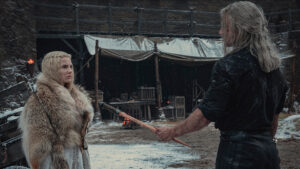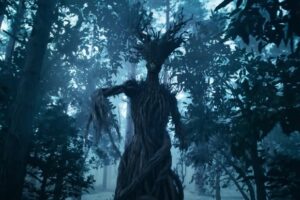MINOR SPOILERS FOR THE WITCHER SEASON 2 AHEAD!
With the universe of The Witcher expanding at the rate that is, and Netflix investing in live-action prequels, anime spinoffs, and even a kid’s show (I have…so many questions about how that’s gonna work), there was a lot of pressure on The Witcher‘s second season to validate that level of support from the streaming service. The first season was good, don’t get me wrong, but it takes more than “good” for Netflix to bank so heavily on any of their original franchises – especially one with a large budget and a star whose salary doubled between seasons.

So it’s fortunate indeed that The Witcher season two gleefully one-ups its debut season at every opportunity and on every level. Showrunner Lauren Hissrich has consistently proven in her social media interactions with fans that she’s always willing to listen and engage with valid critiques of her work on season one, and in season two it appears that she and her team have taken great care to evolve in response to those critiques while staying true to her over-arching vision for the series. The process of achieving that delicate balance begins in the writers room.
That’s where it must have been decided to stick to just one timeline from now on, after audiences responded poorly to the gradual reveal in season one that the show had been jumping between three timelines without warning. To be fair, that reveal works better on a rewatch, when you can pick up all the clues that the writers cleverly planted in early episodes, and I hope season two will be equally as rewarding on successive rewatches; because on a first viewing, to someone who hasn’t read the books or played the games, I think it’s the politics that are going to be most challenging to follow in season two.
I encourage anyone new to The Witcher to find themselves a detailed map of The Continent online before settling in to watch season two, because whether you can keep up with which kingdoms are fighting over what, much less play along with all the political intrigue on your own, will largely depend on how fast you can figure out where the kingdom of Redania is in relation to Cintra and where everything is in relation to Nilfgaard. Most fantasy stories on this scale will have some character in-universe unfurl a map to help out the audience – The Witcher is not most fantasy stories, so you’re gonna have to bring your own.
If you can get past that hurdle, the political intrigue of The Witcher is well-executed, satisfyingly complex…and integral to this season and the forward direction of the series. If Yennefer (Anya Chalotra) was your favorite character in season one because you loved exploring the world of the Mages with their secretive individual agendas and allegiances, you’ll find much to enjoy in season two as the Mages clash with new characters like Dijkstra (Graham McTavish), a man with an almost Machiavellian cunning, and old characters with new goals, like the ostracized Nilfgaardian Mage Fringilla Vigo (Mimî M. Khayisa).
In other words, this season of The Witcher was tailor-made for me. Political intrigue is one of my favorite tropes in fantasy, and as much as I love seeing Geralt (Henry Cavill) hunt monsters, especially now that Ciri (Freya Allan) is in on the action with a sword of her own and some very cool magic abilities, I’m always gonna gravitate more towards the cloak-and-dagger stuff, the conspiracies behind closed doors, the plots and the political maneuvering enriched by the addition of a magical element in this case. But rest assured, monster lovers, The Witcher hasn’t forgotten you.
Following complaints that season one was suspiciously light on monsters for a show about a monster-hunter, season two brings a number of new beasts off the pages of Andrzej Sapkowski’s books and into live-action. By the end of the season, The Witcher is just about testing the limits of its expanded budget (without getting into spoilers, there are several basilisks in the finale, each a little less convincing than the last), but you can tell that the show has more money and resources to allocate towards CGI, because the fight-scenes are longer and better-lit, showing off the cool monster designs rather than hiding them in shadows.
There are monsters where there don’t even need to be monsters in season two, which is an improvement over almost no monsters at all. The Bruxa (a bloodsucking shapeshifter) and the Leshy (a malevolent tree) are by far my favorites; both enigmatic, both hauntingly beautiful, and both absolutely terrifying. If there’s a tiebreaker between the two, it’s the Leshy’s relative lack of screentime and personality that pushes the Bruxa into the lead. I’d say it’s impressive that the Leshy made any impact on me at all in just forty-five seconds, but that’s actually very telling of how much I love evil trees.

The Witcher and its monsters are deeply rooted in Slavic (specifically Polish) folklore, and even monsters original to the Netflix series are designed with the same cultural influences in mind. Season two introduces a haggard demoness named Voleth Meir (Ania Marson, a Polish screen legend), nowhere to be found in Sapkowski’s books but immediately familiar to fans of Baba Yaga (me, again). At first she’s just a creepy witch living in a hut in the woods, but then the hut lifts itself up and…well, if you know the Baba Yaga myth, you know what’s underneath.
Voleth Meir is one of several characters in season two linked to events that took place long before The Witcher, which will presumably be explored further in the live-action prequel series, Blood Origin. A sneak-peek at Blood Origin is attached to The Witcher‘s season finale as a mid-credits scene, and with how much worldbuilding there is in regard to Elven bloodlines, the mysterious black monoliths scattered across the Continent, and the fabled Conjunction of the Spheres, I imagine that a lot of fans will want to check that out to see how closely the two series’ are intertwined (also because it stars Michelle Yeoh).
In much the same way that a map is important to understanding the political intrigue elements of The Witcher, I feel that Blood Origin may be essential viewing to figure out what actually happened in this season at all – and there’s a big difference between expecting viewers to look at a map and asking that they watch two series’ (one of which isn’t out yet) just to understand the one they actually came for in the first place. By contrast, Nightmare Of The Wolf is complimentary to The Witcher and fills in some gaps regarding our knowledge of Vesemir (Kim Bodnia), but you needn’t have watched it to understand his character’s actions.
Thankfully, even as its plot occasionally strays towards the past, The Witcher is anchored in the here-and-now by a trinity of exceptional performances from Cavill, Chalotra, and Allan. Throughout season one, Chalotra did most of the dramatic heavy lifting for the trio, it has to be said. And I will argue that even in season two, she’s still given the most compelling material to work with, but the burden of “carrying the show” is more evenly divided between the three when the season opens, Cavill’s Geralt and Allan’s Ciri having already met at the very end of season one.
It’s the first time in her flight across the Continent that Ciri has paused long enough to have a proper conversation with anybody, but Allan is able to quickly and deftly mold a three-dimensional heroine out of her character, who was little more than a plot-device in season one. As she gives voice to her trauma and inner tumult, we explore more facets of her personality beyond the poise and shy politeness hammered into her by her grandmother – including a ceaseless hatred for her family’s enemies that burns within her body, manifesting itself in violence that both terrifies and mesmerizes Ciri.
Disappointingly, the one element of Ciri’s character that didn’t quite make it to the screen in this season is her bisexuality. Several deleted scenes apparently exist of her crushing on the Mage Triss Merigold (Anna Shaffer), along with one that would have confirmed the Witcher Lambert (Paul Bullion) as a bisexual character. That these scenes were removed so methodically is obviously frustrating. As for the bard Jaskier (Joey Batey), his character is more overtly queer-coded than ever, but the only evidence that he harbors any unrequited romantic feelings for Geralt is one confusingly emotional break-up song about the Witcher.

Deprived of his muse, however, it appears that the bard has lost his touch for clever, catchy songwriting. The break-up song, titled “Burn”, disappoints immensely and is even ridiculed in-universe by some of Jaskier’s audience. It’s certainly not a worthy successor to “Toss A Coin To Your Witcher”, Jaskier’s stirring hymn to Geralt that became a smash hit in real-life and on the Continent, where a star-struck fan even boldly approaches Jaskier with his extremely meta criticisms of the bard’s other work, including one song with too many “different timelines”.
It would certainly have been ironic if The Witcher‘s second season had continued the analogy by falling as flat as Jaskier’s new songs. But happily, this is one series that just keeps getting better across the board, and I’m very excited to see whether season three can raise the bar still further.
Series Rating: 8.5/10